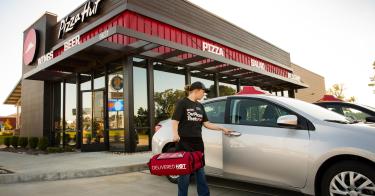My foray into the workforce was a minimum-wage job making pizzas and washing dishes at Pizza Hut.
The money I earned supported my spending as a new driver and taught me how to budget and save for the future. And the experience I gained—everything from teamwork to customer service to safety standards—has carried with me throughout my career.
If I were growing up in California today, that same job opportunity probably wouldn’t exist.
As a 16-year-old without experience, I couldn’t produce $20 per hour of value for Pizza Hut—or probably any company. But $20 per hour is where Assembly Bill 1228 in California sets the bar for fast-food workers. After factoring in mandatory employment taxes, that comes out to more than $48,000 per year for a full-time employee.
Not surprisingly, multiple Pizza Hut franchises announced they are laying off 1,200 delivery drivers. These drivers are likely just the first of potentially thousands more fast-food workers who will lose their jobs.
Like me, most Americans start out earning the minimum wage. And like me, most Americans are not capable of producing over $48,000 in value right out of the gate. Mandating the employers pay workers more than they can produce simply raises the bar on employment, excluding those who cannot reach it yet.
When lawmakers attempt to “help” lower-wage workers by mandating higher minimum wages, they often end up causing more harm than good. As the late Walter Williams warned aboutminimum-wage laws, “intentions have no effect on outcomes.”
The unintended negative outcomes of minimum wages increases are well documented.
Multiple analysis from the Congressional Budget Office estimate that large federal minimum wage increases would: cost hundreds or thousands or millions of jobs; drive up prices, interest rates, and federal deficits; reduce total family incomes; and cause hundreds of thousands of workers who lose their jobs to permanently drop out of the labor force.
Individuals with low-education, disabilities, criminal records, limited English, and teens are most likely to lose their jobs.
A study by the Employment Policies Institute found that the 40% increase in the minimum wage in 2009 contributed to a 15.5% decline in employment among workers with less than a high school diploma and an 8.9% decline in teen employment (which rose to 29.8%).
Minimum-wage jobs aren’t meant to be careers or family-supporting jobs, but they nevertheless play a crucial role as a stepping stone into more advanced and higher-paying employment. The individuals who have initial job opportunities cut off by precipitous minimum-wage hikes suffer lifelong consequences.
Studies show that workers who held part-time jobs as teens have 7% higher earnings than their peers who didn’t have part-time jobs. Further, individuals exposed to high minimum wages have lower future earnings, and those who suffer job losses from minimum-wage increases are more likely to be arrested for property crimes.
Another consequence of minimum-wage hikes is higher prices because naturally, when employers have to pay workers more to do the same thing, they have to raise their prices. When New York City increased its minimum wage from $13 to $15, 86% of restaurants said they raised their prices, and 40% reported losing repeat customers. Fewer customers means fewer workers are needed.
Even more seasoned workers who retain their jobs could be worse off despite receiving a pay raise. That’s because restaurants in California could also adjust to the $20 minimum wage by cutting worker hours, eliminating benefits like health insurance and imposing on-demand scheduling.
California lawmakers may think that mandating higher wages could help address issues like housing unaffordability, high crime rates, homelessness and rising costs, but the evidence shows it could have the opposite effect.
That’s because laws can’t create higher incomes—they can only redistribute incomes. The only way workers can achieve lasting real wage gains is by becoming more productive.
To that end, state policymakers should eliminate unnecessary licensing requirements so that people don’t need a costly license to braid hair or arrange flowers. Federal lawmakers should end the government’s monopoly on registered apprenticeships so that more people can get paid while being trained for successful careers. And all levels of government should remove unnecessary regulations so that more of businesses’ estimated $12,800 per employee in annual regulatory costs could go toward higher wages and investments in workers.
Such policy changes may not poll as well as a $20 minimum wage, but they’ll actually help workers. And isn’t that the goal?
This piece originally appeared in MSN




